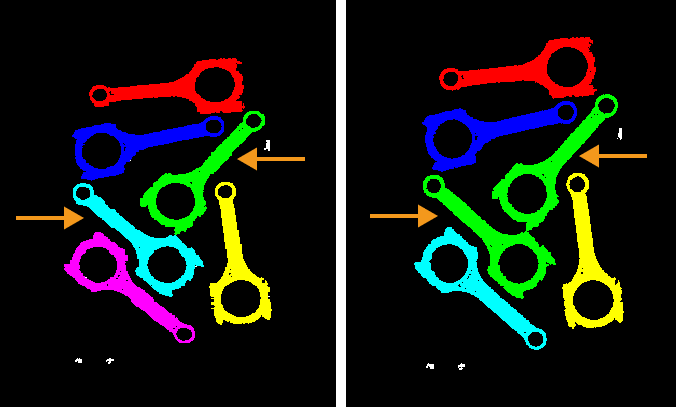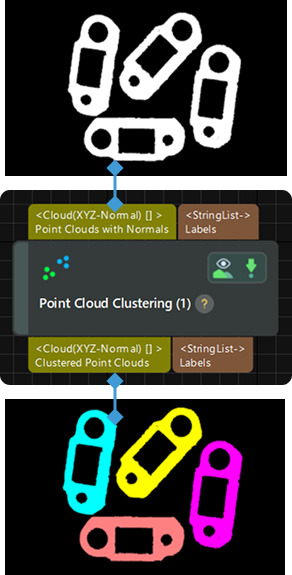Point Cloud Clustering
Function
This Step can perform point cloud clustering according to specified rules, often used for segmentation of target objects.

Usage Scenario
This Step is usually used for point cloud preprocessing to eliminate interference from unwanted point clouds.
Parameter Description
- Cluster Algorithm
-
Description: This parameter is used to select the clustering method.
List of values: EuclideanCluster, RegionGrowingSeg
-
EuclideanCluster: Euclidean clustering determines whether points belong to the same cluster based on distance threshold.
-
RegionGrowingSeg: Region growing segmentation determines whether points belong to the same region based on the difference in normals and curvature between neighboring points.
Default value: EuclideanCluster
Tuning recommendation: It is recommended to use the default value.
-
The following sections introduce the parameters for the two clustering methods above.
EuclideanCluster
- Max Distance Between Neighboring Points in Output Clusters
-
Description: This parameter is used to set the maximum distance between points in the cluster. When this parameter is increased, points that are farther apart will be grouped into the same cluster. When it is decreased, points that are closer together will be grouped into different clusters.
Default value: 3.000 mm
Example: As shown in the figure below, the left image shows the clustering result when this parameter is set to 3.000 mm, and the right image shows the result when adjusted to 5.000 mm. After adjusting the parameter, the point clouds indicated by the orange arrows are all green, which means that they are classified in the same cluster.

- Min/Max Point Count per Cluster
-
Description: This parameter is used to filter the clustering results. Only point clouds with a point count between the two parameter values will be output.
Default value: 800/3000000
Tuning recommendation: It is recommended to use the default value.
Example: Assume the point counts of the clustered point clouds are 10,000, 20,000, 30,000, 40,000, and 50,000 respectively. If the Max Point Count per Cluster is set to 45,000, and the Min Point Count per Cluster is set to 15,000, then the clusters with 10,000 and 50,000 points will be filtered out, and only the clusters with 20,000, 30,000, and 40,000 points will be output.
RegionGrowingSeg
- Number of Neighbours
-
Description: This parameter is used to set the number of neighboring points to be compared for each point. When this parameter is increased, more points will be used for comparison, which will lead to fewer clustering results.
Default value: 30
Tuning recommendation: It is recommended to use the default value.
- Smoothness Threshold
-
Description: When this parameter is increased, the tolerance for normal angle differences between neighboring points becomes larger, and points with larger normal angle differences will still be grouped together.
Default value: 4°
Tuning recommendation: It is recommended to use the default value.
- Min/Max Point Count per Cluster
-
Description: This parameter is used to filter the clustering results. Only point clouds with a point count between the two parameter values will be output.
Default value: 800/3000000
Tuning recommendation: It is recommended to use the default value.
Example: Assume the point counts of the clustered point clouds are 10,000, 20,000, 30,000, 40,000, and 50,000 respectively. If the Max Point Count per Cluster is set to 45,000, and the Min Point Count per Cluster is set to 15,000, then the clusters with 10,000 and 50,000 points will be filtered out, and only the clusters with 20,000, 30,000, and 40,000 points will be output.
